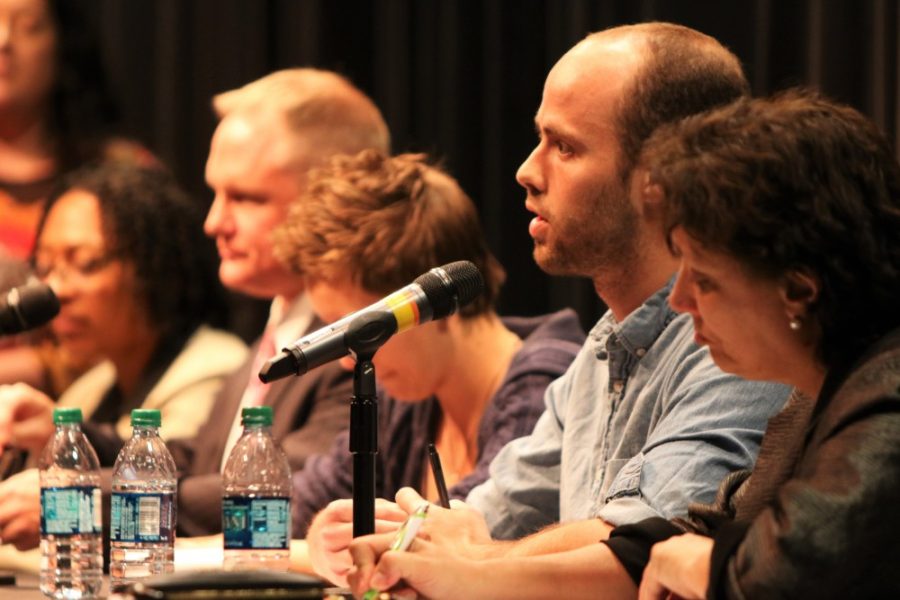The right to free speech has been a hot topic of discussion at the UA recently — where, when and what dictates the line between protected and harassing speech has been debated by multiple campus groups and organizations.
It has been such a source for controversy lately that the Dean of Students Office brought together five experts on the First Amendment and its boundaries to discuss free speech at the UA in the talk, Fearless Expression: Religion, Politics and Free Speech at the University of Arizona.
Moderated by current Associated Students of the University of Arizona and Graduate and Professional Student Council Presidents Manny Felix and Sarah Netherton, the talk was lead by a five-person panel comprised of experts and community members who were well versed in free speech boundaries and uses.
Panelists were: Kelly G. Bauer of the University Religious Council, Kat Hermanson, director of advertising for Pride Alliance, Toni Massaro, professor of law, Devon Moule, UA academic adviser and Kendal Washington White, assistant vice president and dean of students.
The discussion centered around the legal boundaries of the First Amendment, what students can do to combat offensive speech and what the university’s role is.
“The university is obliged to first protect the speaker, only
if its impossible can they then ask the speaker to stand down,” Massaro said, outlining the thin line that universities must toe when it comes to free speech. ”So that is a big
load for everyone who works, lives plays [and] thinks here. Because it means that we
are expected to tolerate a real large amount of noise on campus.”
Campus preachers may have the right to speak — within reason — on UA grounds, but the panel was quick to remind the audience that those who disagree with them have an equal right to speak and demonstrate. All five panelists suggested a strategy of “counter speech,” which is basically fighting fire with fire, devising ways to out-demonstrate and speak over potentially offensive people such as campus preachers.
Moule, who in addition to being a current faculty member is also alumnus of the UA, cited an example of counter speech he helped organize as a student working with the Women’s Resource Center.
When infamous campus preacher Brother Dean Saxton first made his debut on the UA campus, his signs and slogans professing to passerbys that “you deserve rape” blindsided the campus community. Particularly many who came in to the WRC, according to Moule.
While many were calling for Saxtons’ expulsion — which the university couldn’t and wouldn’t do — Moule and the WRC devised a strategy of counter speech. They stole Saxton’s “you deserve rape” slogan, removed the word, “rape” and replaced it with a bank space for people to write things that they felt they actually deserved. Words and phrases like “love” and “to go to class without feeling harassed” filled the blank spaces on the signs, according to Moule. He added that not only did hundreds of people write on the signs, but many of them stuck around the area where Saxton was and held them.
Hermanson pointed out that students retaliated to counter speech this February when a group of campus preachers visited the university.
READ: Campus preachers: Do they belong?
On two separate occurrences, students employed counter speech that week. One group, that Hermanson said her partner helped organize, staged a “sound out,” where a group pumped a low frequency hum through a large set of speakers to literally drown out the preachers. The second group donned large angel wings and formed a line around the preachers, blocking them from the view of students passing by.
Washington White said that college campuses attract preachers and demonstrators because it is an easy and accessible way for them to spread their message to a large, diverse audience.
“We are a ripe organization and area for these kind of things to happen,” Washington White said, adding that this sense of openness and accessibility of a college campus is both a blessing and a curse.
Nearing the end of the discussion, the floor was opened to the audience to ask questions of the panel.
Regarding an earlier comment from a panelist about the difference between adversarial speech and the “true threats” that aren’t protected under the First Amendment, a audience member asked how a person can tell the difference between the two.
“I feel very, very uncomfortable when Brother Jeb tells me
to grow my hair out, put on a dress and get back in the kitchen,” Hermanson said, responding to the question.
“I feel unsafe when some fuck-head in a white truck follows me and my partner
home and yells ‘dyke’ out the window. Those are very, very different
situations.”
Follow the Daily Wildcat on Twitter.









